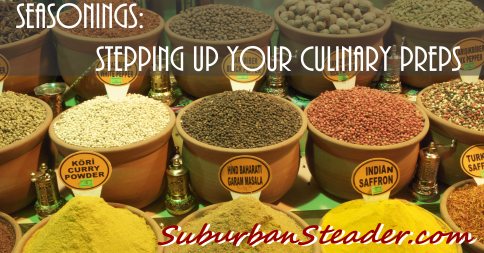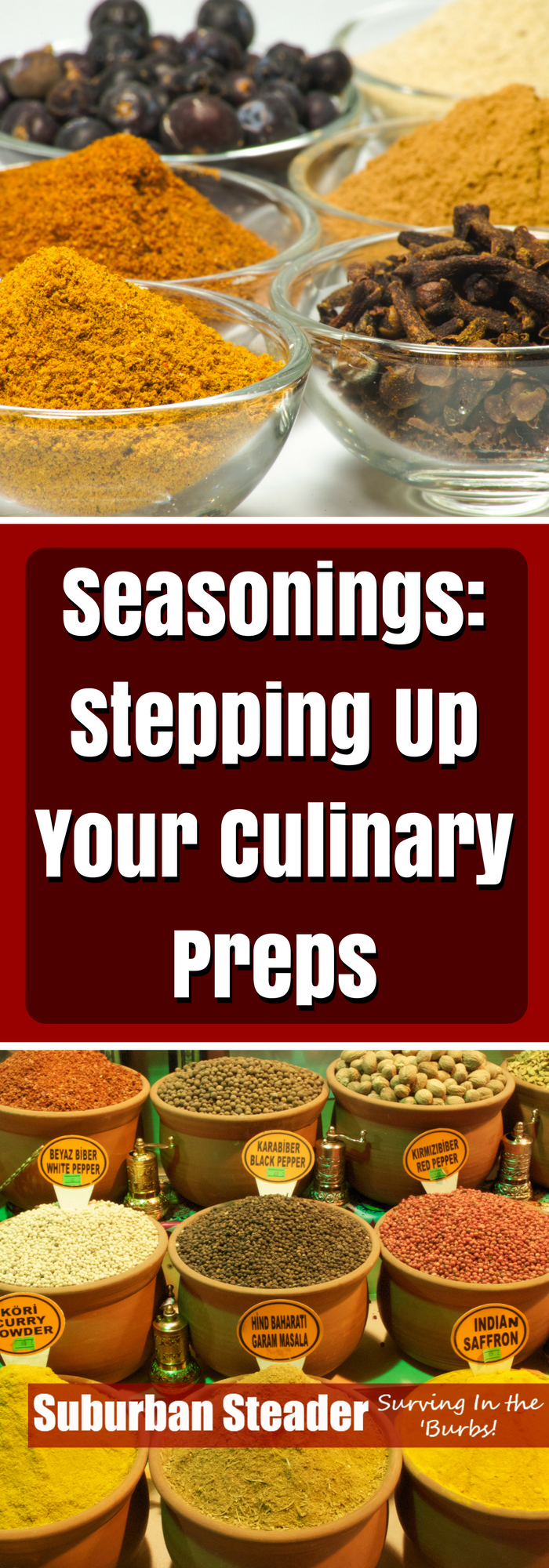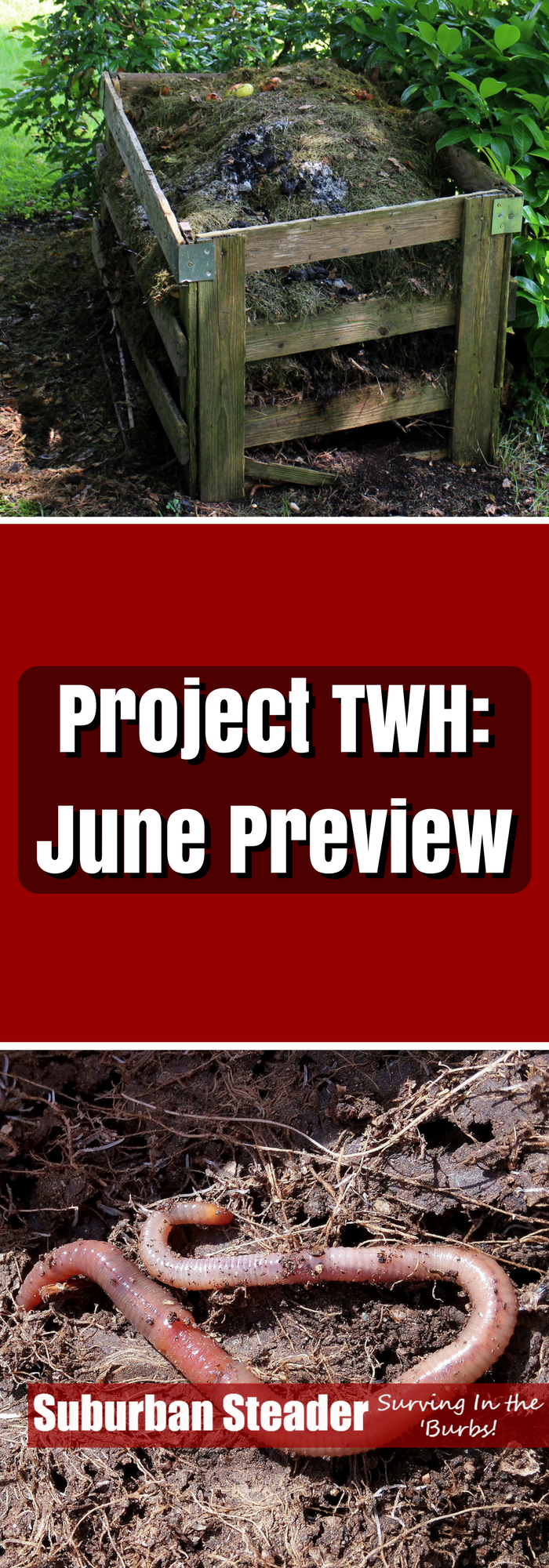Seasonings: Stepping Up Your Culinary Preps
We’re going to talk about seasonings today in our second cooking-related Project TWH post. In case you missed it earlier, our first cooking-related post in Project TWH was about Nutrition For The Suburban Homesteader.
Why Seasoning Is Essential To Homesteaders
Let’s get this fact out-of-the-way right off the bat – bland food sucks! Monotony does too. Picture this very realistic scenario:
Your suburban homestead garden is successfully producing this year and you’ve got more tomatoes, carrots, cucumbers and broccoli than you know what to do with.
At first, this problem is anything but a free problem. The vegetables are fresh and taste great. But in the not too distant future, you’re getting sick of all these vegetables in your diet. It’s just annoying to eat the same thing over and over and over and over again despite how fresh these vegetables are.
But, add some seasoning – garlic to the broccoli, sage to the carrots, salt and balsamic vinegar to the tomatoes, dill (with some yogurt) to the cucumbers – and, all of a sudden, these mundane flavors are once again exciting!
Seasonings make food more interesting and also allow you to be creative with your cooking!
Types of Seasonings
We can spend a long, long time talking about seasonings, but let’s start talking about the basics.
- Herbs: The flavor in herbs comes from the leaves of the plant. A lot of these seasonings can easily be grown in your garden.
- Spices: Anything used to season food that is not made from the leaves of a plant are considered a spice. A lot of these items are difficult to grow in a typical garden in the U.S., however some like chili peppers and fennel seeds are able to be grown in the U.S.
- Black Pepper: A typical staple in every pantry, this seasoning can only be grown in tropical climates. It is, however, almost a required, essential seasoning for any setting. The ability for only a light sprinkle to make an astounding difference is incredible!
- Salt: Due to the fact that it is not a part of a plant, salt is neither a herb or a spice. It is, however, much like black pepper in that it is essentially a required staple due to its ability to greatly change (most will say improve) flavor in small amounts.
- Onions and Garlic: Both are vegetables and, at the same time, both are used primarily to alter the taste of other food rather than as a major. Onions have a sweet, but not sugary, flavor to meals. Garlic has a unique flavor and is able to turn a simple dish (think steamed broccoli) from a mundane dish to a tasty dish. It has amazing health benefits as well.
- Vinegars: A liquid seasoning that can help you spice up salads and other vegetable dishes. There are multiple different flavors that range from sweet (balsamic vinegar) to subtle (apple cider vinegar).
Grow Your Own Seasoning
There’s two ways to effectively start using seasoning in your cooking. The first approach is determining which seasonings you like and thane making dishes that use them. The second is finding dishes that you like and figuring out what seasonings work well with them. In the end, it’s probably best to use a combination of these approaches. That being said, the average suburban homesteader can grow most of the seasonings listed below and could easily try incorporating them in their cooking.
- Basil: This plant is very simple to grow, although it is frost sensitive. It also has some propensity to experience fusarium wilt in the Deep South. Basil grows great from seeds that are planted after the frost-free date. We use basil extensively with tomatoes here on the Suburban Steader homestead – tomato and mozzarella slices with chiffonade basil and balsamic vinaigrette is a terrific appetizer for summer meals.
- Chili Peppers: These peppers are grown just like bell or sweet peppers. And, much like sweet peppers, the fruits can be eaten. They can also be dried and used for seasoning foods in the winter. Chili peppers have a spicy taste to them and are used extensively in Mexican and Asian-style cooking.
- Coriander / Cilantro: A definite “two-for-one” in the seasoning world. Cilantro leaves are typically used in Mexican-style cooking. Coriander, on the other hand, is associated with many different styles of cooking. Both have very unique flavors. Unfortunately, the Mrs doesn’t like cilantro very much, so it is not used very much on the Suburban Steader homestead.
- Egyptian Onions and Chives: Both of these perennials are grown mostly for their green leaves. Their taste profile is similar to onions or garlic but neither have as sharp a flavor as the latter. The Suburban Steader homestead always has some chives on hand for numerous things but one of our favorites is adding these great seasonings to tuna, egg or chicken salads.
- Garlic: Probably my favorite seasoning, garlic has many uses. Almost every dish, regardless of cuisine, can benefit from some minced up garlic. Garlic typically goes hand in hand with onion. We use the age-old ratio of three garlic cloves to one onion in most meals and it works great. The taste of garlic is wonderful and the health benefits (as mentioned above) are incredible which makes it no surprise that garlic is the most used and appreciated seasoning in the Suburban Steader homestead. Garlic is planted in the fall and harvested in the summer.
- Mint: Probably the easiest seasoning to grow, mint can also be a problem in your garden. It is known as a runner meaning that the roots will spread and consume a large area. It is recommended that you use either a separate pot or root barriers when growing mint. All that being said, mint is quite a useful seasoning. It is matched well with some meats – lamb especially – and is also great for making teas. In addition, mint is a great addition to some adult beverages. In addition to normal mint, you might want to experiment with different variations like spearmint or peppermint.
- Onions: Just like garlic, onions have almost limitless use. They can be eaten raw on sandwiches – they are terrific on hamburgers – or diced and sautéed as the base for numerous dishes. Onions are planted from seed or set early in the spring and the bulbs are harvested mid-summer. Onions have a unique ability to add a sweetness to a dish that is nothing like the sweetness sugar adds. The aroma and taste onions add as seasoning to a dish is unique and it is added to many dishes here on the Suburban Steader homestead.
- Oregano: This fast growing perennial is hardy down to Zone 5 (learn about USDA Hardiness Zones here). Much like mint, oregano can be a runner so make sure you use some kind of root barrier or a separate pot when growing oregano. Oregano is used a lot in both Italian and Mexican cuisines and is a mild, but tasty seasoning.
- Parsley: Much like onions and garlic, parsley is best known for its extensive use in Italian cuisine. It is a biennial meaning that it is harvested in the first year and bolts to seed in the second spring. Much like cilantro and basil, parsley is grown for its leaves. A fine-chopping of parsley is a great addition to any Italian-style dish as well as many soups and pasta dishes.
- Rosemary: This terrific seasoning has many uses but is best known as a great seasoning for most starches. Our favorite use of rosemary is as an addition to roasted red potatoes. Rosemary is a perennial that will grow hardly in the South and may die back some in the cold of winter in anything less than Zone 7.
- Thyme: Another perennial that is hardy down to Zone 5, thyme is a great seasoning for both vegetables and different kinds of meat. Here at the Suburban Steader homestead, we use thyme a lot with chicken. We’ll take a few chicken breasts, rub them in a little olive oil, salt, pepper and paprika, toss a sprig or two of thyme on the chicken and bake them. This process makes the chicken tasty and a great addition to salads.
Testing New Seasonings
So you’ve taken the plunge and are growing a bunch of the seasonings from above but don’t know where to start when it comes to trying them. Do you find the seasonings you like and then find meals that use them? Or, do you figure out what seasonings you can use to spice up the meals you already like? Ideally, you’ll do both.
Here on the Suburban Steader homestead, we definitely take the two-prong approach to trying new spices. For instance, there are quite a few meals that we’ve become very good at making such as different grilled meats, chicken meals and pasta with red sauce. We’ve begun to play with different seasoning profiles on these dishes to spice them up and change the typically taste of the dishes so we don’t get bored.
On the other side, we’ll occasionally buy a seasoning from the store (sage was one of the latest we tried) and found recipes that highlight it. Not everything works out well, but it’s opened up our palettes and has allowed us to expand both our taste profiles and our culinary skills.
Exploring new seasonings is definitely a win-win experience in both the taste and culinary skill worlds!

photo credit: Tord Sollie via photopin cc

